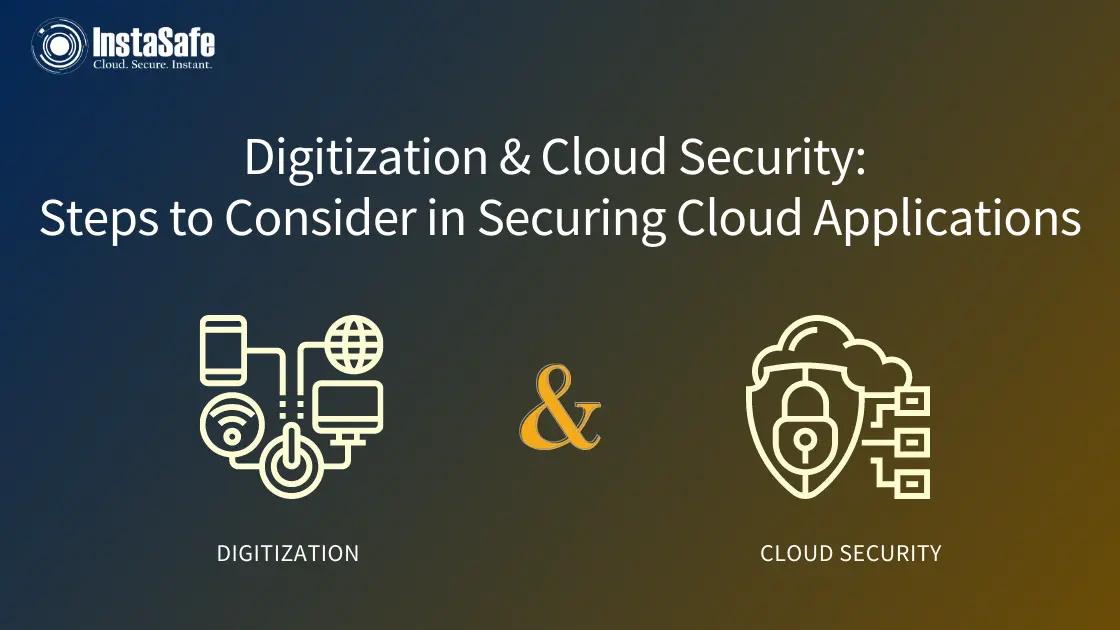Digitization & Cloud Security: Steps to Consider in Securing Cloud Applications

There are hardly any companies today that store all their data locally. With remote working becoming the new normal, private and sensitive data of companies is increasingly flowing outward through the cloud infrastructure. Under such rapidly changing circumstances, rapid digitization is key to not just growth but for survival.
While companies are focusing on digitization, it would help them immensely if cloud security is given equal precedence. Ensuring both aspects move parallel always help companies avoid a lot of potential trouble in the near future.
Cloud security is a rather broad term. It basically involves protecting any and all data that resides on cloud computing platforms. The obvious threats to such infrastructure are data theft, leakage, and deletion. Companies often have to deal with internal and external threats while securing the data stored in the cloud.

Cloud computing and cloud applications have become the backbone for businesses and governments. Hence there has to be a robust cloud security plan to shield data and applications from the ever-present digital threats.
Understanding Cloud Security and how it affects Digitization drives:
Cloud security needs differ based on the category of cloud computing infrastructure the company utilizes. Some of the main categories of cloud computing are as follows:
- Public cloud services: Software-as-a-service (SaaS), infrastructure-as-a-service (IaaS), and platform-as-a-service (PaaS).
- Private cloud services: Usually a single customer avails the entire remote computing facility.
- Private cloud services: Evolution of the traditional data centre. This involves trained internal staff operating cloud infrastructure.
- Hybrid cloud services: Combined private and public cloud computing configurations. They host workloads and data. Factors such as cost, security, operations and access govern operational decisions. Operations typically involve trained internal staff, and optionally involve a reputed public cloud provider.
Security threats are constantly evolving. Malicious code writers, which involves hackers, ransomware, spyware, cryptocurrency miners, etc. are becoming more sophisticated. Cloud computing isn’t completely immune to cyber threats. Hence, companies relying on cloud applications must not only work with a reliable cloud service provider but also partner with platforms that offer best-in-class security customized for the infrastructure available.
Steps to consider in securing cloud applications:
Cloud security solutions generally do not come in ‘one size fits all’ packages. Every company and its needs differ wildly. This is because cloud infrastructure is well known for its scalability. Small applications distributed to a few select employees differ from cloud applications that thousands of employees, partners and consumers, can access through multiple devices. Implementation of cloud security processes, however, must always be a joint responsibility between the application owner and cloud solution provider.
As mentioned above, the steps involved in availing or deploying cloud security varies with the applications, platforms, size of infrastructure needed, etc. However, some of the key considerations while securing cloud applications is as follows:
Centralized security:
Cloud computing centralizes applications and data. Similarly, cloud security should also centralize protection. Cloud-based business networks involve multiple devices, often called endpoints. The rapidly emerging BYOD (Bring Your Own Device) culture further complicates security considerations.
A cloud security solution should offer centrally managed traffic analysis and web filtering. Constant monitoring of data flows ensure anomalies are spotted quickly and stemmed before they cause problems. A cloud security platform can also ensure quick and reliable disaster recovery with efficient risk mitigation.
Reduce Administration:
Cloud infrastructure security platform reduces the need for manual security configurations. There’s a significant reduction in applying security updates or patches. A robust security platform aims to reduce the need to “constantly manage” security parameters and threats.
It is, however, important to carefully set permissions and access control in the very beginning of deploying cloud applications. Such steps help in automating security protocols, and safeguards data.
Ensure visibility of cloud data:
Cloud services are often way outside the corporate network and accessed from devices not managed by IT. Hence administrators may have limited visibility. A robust cloud security platform should allow a good overview, without compromising user privacy.
Compliance:
A cloud security provider must offer good counselling about regulatory and internal compliance. Regulatory requirements such as HIPAA, PCI and Sarbanes-Oxley, as well as requirements from internal teams, partners and customers, can throw challenges.
Insider threat mitigation:
Threats might not always originate from the outside. There has been data exfiltration owing to mistakes from employees. Hence, a Zero Trust approach is now mandatory for any secure cloud application.
Only allowing users access to network or data after ensuring need or right to access always vastly reduces data leaks and threats. Cybercriminals often rely on “blind trust” on employees to misuse stolen credentials.
Protection against Lateral Movement Attacks:
Social engineering, phishing, malware, attacks are quite common. These can comprise data integrity simply because attackers use legitimate accounts to access sensitive data and networks. Commonly referred to as Lateral Movement Attacks, such security breaches are quite damaging.
A cloud security provider must have protocols to monitor and catch suspicious account activity. Moreover, other policies such as Multi-Factor Authentication, security tokens, hardware-based keys, etc. are possible risk mitigation solutions.
Remotely securing perimeters for data islanding:
Even if an attacker manages to secure authentic login credentials, setting up virtual perimeters is a reliable method to limit movement and access to sensitive data. Setting up such parameters is part of configurations. A cloud security provider must include guidance to properly configure access.
Data and network islanding are like setting up virtual boundaries. Access to certain areas and data must always be restricted or limited and granted only when needed and only as long as needed.
Some of the major threats to cloud security today include data breaches, data loss, account hijacking, service and traffic hijacking. However, poorly configured Application Program Interfaces (APIs), unreliable cloud storage providers, and old technology can easily compromise cloud security. A reliable cloud application security provider also deals with Distributed Denial of Service (DDoS) attacks.
Cloud infrastructure presents ample opportunity to quickly scale products, services, and solutions. However, the very nature of the cloud infrastructure makes it a very lucrative target. Cloud security solution differs from traditional platforms. But the security considerations and parameters, which involves constant overwatch, and dynamic threat assessment remains the same.
Key Products
Zero Trust Application Access | Zero Trust Network Access | Multi Factor Authentication | IAM Identity And Access Management | Secure Enterprise Browser
Key Features
SSO Single Sign On | Endpoint Security | Contextual Based Access Controls | Always On VPN Connection |Clientless VPN | Device Binding | Device Posture Check | Domain Joining
Key Solutions
VPN Alternative Technology | Secure Remote Access Solutions | Cloud Application Security | DevOps Security | VoIP Security Solutions
